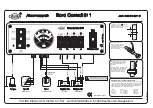
User Manual
Airbridge cBTS3612 CDMA Base Station
System Description
2 Hardware Architecture
2-44
Sector
α
Sector
β
Sector
γ
Antenna
Feeder
Jumper
Jumper
BTS cabinet
Figure 2-24
Structure of RF antenna & feeder
I. Antenna
Antenna is the end point of transmitting and start point of receiving. Type, gain,
coverage pattern and front-t o-rear ratio of the antenna can affect the system
performance. The network designer should choose antenna properly based on the
subscriber number and system coverage.
1) Antenna gain
Antenna gain is the capability of the antenna to radiate the input power in specific
directions. Normally, the higher gain, the larger coverage. But there may be blind
area in the vicinity.
2) Antenna pattern
Antenna pattern describes the radiation intensity of the antenna in all directions. In
the field of telecommunication, it usually means a horizontal pattern. BTS antenna is
available in two types: 360
â
omni antenna and directional antenna. The directional
antenna includes the following types: 120
â
, 90
â
, 65
â
and 33
â
.
3) Polarization
Polarization is used to describe the direction of the electrical field. The mobile
communication system often uses uni-polarization antennas. Bi-polarization
antennae have been used recently to reduce the quantity of antennae. The two
polarization directions are perpendicular to each other.
















































